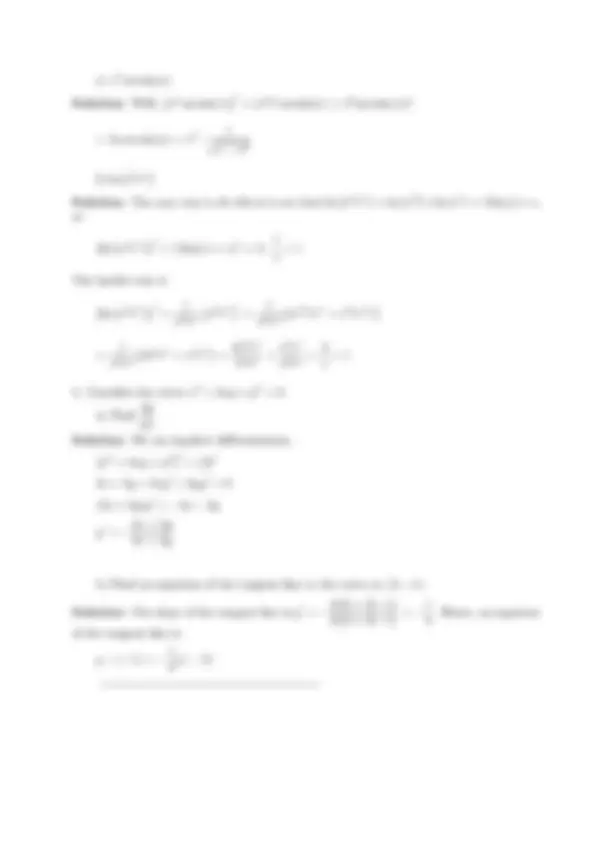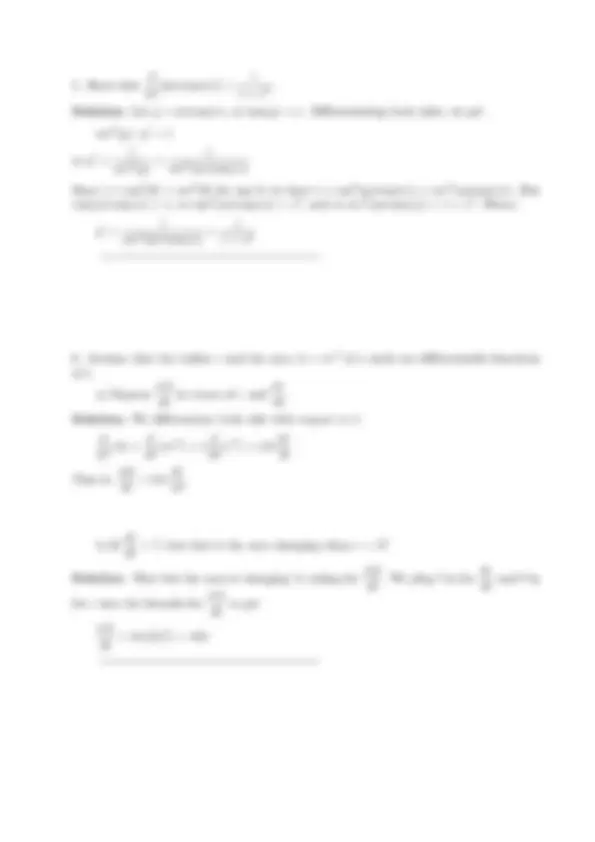




Study with the several resources on Docsity

Earn points by helping other students or get them with a premium plan


Prepare for your exams
Study with the several resources on Docsity

Earn points to download
Earn points by helping other students or get them with a premium plan
Community
Ask the community for help and clear up your study doubts
Discover the best universities in your country according to Docsity users
Free resources
Download our free guides on studying techniques, anxiety management strategies, and thesis advice from Docsity tutors
Material Type: Exam; Class: Calc for Biol Sci I >4; Subject: Mathematics; University: University of Oregon; Term: Unknown 2011;
Typology: Exams
1 / 4

This page cannot be seen from the preview
Don't miss anything!



x
. Use the limit definition to show that f ′(x) = −
x^2
Solution: Well, f ′(x) = lim h→ 0
f (x + h) − f (x) h = lim h→ 0
1 x+h −^
1 x h
= lim h→ 0
h
x + h
x
= lim h→ 0
h
x − (x + h) x(x + h)
= lim h→ 0 −h hx(x + h) = lim h→ 0
x(x + h)
x(x + 0)
x^2
Using this information, answer the following questions:
a) If h(x) = g(x) f (x) , what is h′(5)?
Solution: Well, h′(x) =
g(x) f (x)
g′(x)f (x) − g(x)f ′(x) [f (x)]^2 , so
h′(5) = g′(5)f (5) − g(5)f ′(5) [f (5)]^2
b) If H(x) = g(f (x)), what is H′(5)?
Solution: Well, H′(x) =
g(f (x))
= g′(f (x)) · f ′(x), so
H′(5) = g′(f (5)) · f ′(5) = g′(4) · f ′(5) = (3)(−3) = − 9
a) xπ^ + πx^ + eπ
Solution: Well,
xπ^ + πx^ + eπ^
= πxπ−^1 + ln(π)πx^ + 0
b) √ x 3 x + 1
Solution: Well, x √ 3 x + 1
x (3x + 1)^1 /^2
so
( x (3x + 1)^1 /^2
(x)′^
(3x + 1)^1 /^2
− (x)
(3x + 1)^1 /^2
(3x + 1)^1 /^2
(3x + 1)^1 /^2 − x · 12 · (3x + 1)−^1 /^2 · 3 3 x + 1
c) sin^3
7 x + 4
Solution: Well, sin^3
7 x + 4
sin
(7x + 4)^1 /^5
, so
([ sin
(7x + 4)^1 /^5
sin
(7x + 4)^1 /^5
cos
(7x + 4)^1 /^5
(7x + 4)−^4 /^5
d) 7cos(3x)
Solution: Well,
7 cos(3x)
= ln(7)7cos(3x)
cos(3x)
= ln(7)7cos(3x)
− sin(3x)
(3x)′^ = ln(7)7cos(3x)
− sin(3x)
d dx
arctan(x)
1 + x^2
Solution: Let y = arctan(x), so tan(y) = x. Differentiating both sides, we get
sec^2 (y) · y′^ = 1
so y′^ =
sec^2 (y)
sec^2 (arctan(x))
Since 1 + tan^2 (θ) = sec^2 (θ) for any θ, we have 1 + tan^2 (arctan(x)) = sec^2 (arctan(x)). But tan(arctan(x)) = x, so tan^2 (arctan(x)) = x^2 , and so sec^2 (arctan(x)) = 1 + x^2. Hence,
y′^ =
sec^2 (arctan(x))
1 + x^2
a) Express dA dt in terms of r and dr dt
Solution: We differentiate both side with respect to t:
d dt
d dt (πr^2 ) = π d dt (r^2 ) = π 2 r dr dt
That is, dA dt = 2πr dr dt
b) If dr dt = 7, how fast is the area changing when r = 3?
Solution: ‘How fast the area is changing’ is asking for dA dt
. We plug 7 in for dr dt and 3 in
for r into the formula for dA dt
to get
dA dt
= 2π(3)(7) = 42π